AUCTORES
Globalize your Research
Research Article | DOI: https://doi.org/10.31579/2578-8868/140
State Educational Institutional of Higher Professional Education” M. Gorky Donetsk National Medical University”, DCTMA, Donetsk.
*Corresponding Author: O.I. Lystratenko, State Educational Institutional of Higher Professional Education” M. Gorky Donetsk National Medical University”, DCTMA, Donetsk.
Citation: O.I. Lystratenko, A.M. Kardash, D.O. Lystratenko, V.P. Kardash. (2020) Clinical and Anatomical Rationale for the use of Fronto-Orbito-Zygomatic (foz) approach for the Surgical Treatment of Tumors of the Orbit and Cranioorbital Region. J. Neuroscience and Neurological Surgery. 7(1); DOI:10.31579/2578-8868/140
Copyright: © 2020 O.I. Lystratenko, This is an open-access article distributed under the terms of The Creative Commons Attribution License, which permits unrestricted use, distribution, and reproduction in any medium, provided the original author and source are credited
Received: 10 October 2020 | Accepted: 17 October 2020 | Published: 23 October 2020
Keywords: orbital tumor; ptosis; fronto-orbito-zygomatic approach; subconjuctive approach; rhabdomyosarcoma.
The article discusses and analyzes the results of the treatment of 56 patients with tumors of the orbit, cranioorbital region, operated at the neurosurgery clinic DCTMA in Donetsk from 2015 to February 2020, with various surgical approaches.
Goals and objectives: coverage of clinical signs and symptoms, histology, diagnostic methods and treatment of patients operated on with tumors of the orbit and cranioorbital region for the period 2015-2020. The rationale for the use of front-orbit-zygomatic access as the optimal surgical access to tumors of the orbit and cranioorbital region of various localization, to perform radical organ-preserving surgery, with the maximum preservation of visual function, minimizing oculomotor disturbances, patient disability, good cosmetic effect in the postoperative period.
Materials and methods: we analyzed the clinical cases of 56 patients who underwent treatment in DCTMA with tumors of the orbit, cranioorbital region for the period from 2015 to March 2020.
Patients were operated on with different approaches - transcutaneous, subconjunctival, front-orbit-zygomatic, pterional, subfrontal. Surgical approaches were determined individually, depending on the location, size of the tumor, involvement in the process of the underlying structures of the orbit, adjacent anatomical areas (frontal, maxillary sinuses, cranial cavity, bones of the base of the skull). In 2 cases of lesions of the orbit by the tumor process a relapse of the tumor growth was obtained: one patient with aggressive adenocarcinoma, after 18 months, leading to orbital exenteration, and a 9-year-old child with rhabdomyosarcoma after non-radical removal of the tumor by subconjunctival approach. In all other cases, no relapses were noted; the operations were organ-preserving.
Conclusions: the results of treatment of patients with orbital tumors directly depend on the radical removal of the neoplasm, which is associated with the choice of surgical approach, the use of chemo-, radiation therapy in the postoperative period, depending on the histological response.
Advantages and versatility of FOZ - approach:
─ gives good visibility of all structures of the orbit, paraorbital regions, including the cranial region;
─ allows to perform organ-sparing operations to remove tumors of cranioorbital localization of any size;
─ provides radical removal of the neoplasm;
─ maximum preservation of vision function;
─ minimization of oculomotor disorders, patient disability;
─ good cosmetic effect.
Indications for front-orbit-zygomatic access:
─ large formations of orbit (more than 2.5-3 cm in diameter), with diffuse growth in the capsule, including a metastatic one;
─ osteomas of the walls of the orbit, meningiomas with intracranial, intraorbital growth, fibrous dysplasia of the bones of the skull base, causing compression of blood vessels and nerves, functional disorders of the eye;
─ tumors of the apical part of the orbit, including the optic nerve.
The disadvantages of the method are the technical complexity for ophthalmologist surgeons, by the routinism of the manipulation for neurosurgeon. In this regard, surgery of orbital tumors, cranioorbital localization, is subject to the competence of doctors of related specialties, including neurosurgeons.
Tumors of the orbit are a common pathology. Among all neoplasms of the organ of vision they account 23–25%. Almost all tumors observed in humans are found in orbita. The frequency of primary tumors is 94.5%, secondary and metastatic tumors occur in 5.5%.
As it turned out, their diagnosis is a big problem not only for the ophthalmologist. Due to the anatomical proximity of the orbit to the cranial cavities and paranasal sinuses tumors of the orbit are very diverse, as they can arise from different anatomical structures of the orbit. In this regard not only oculists, but also ENT- doctors, maxillofacial surgeons and neurosurgeons can be involved in the diagnosis establishing and delivery of the surgical care of patients with orbital tumors.
For the effectiveness of diagnosis, we have introduced and use the mandatory algorithm for examining a patient with suspecsion on orbital neoplasm, with individual characteristics for each patient:
─ ophthalmological examination, ophthalmoscopy;
─ X-ray of the orbit and skull;
─ Ultrasound of the orbit, as a screening study;
─ CT scan with intravenous contrast, MRI, to clarify the prevalence of the process;
─ examination of an ENT doctor, neurologist;
─ general clinical blood tests;
─ fine needle aspiration biopsy of tumor tissue and subsequent cytological, histological study of the obtained material.
In the article, we examined the results of the treatment of 56 patients operated on with tumors of the orbit, cranioorbital region, and performed the analyzing the surgical approaches depending on the location and nature of the process. We have identified and justified indications for FOZ – approach in case of neoplasms of this localization.
Materials and methods.
For the period from 2015 to March 2020 in Donetsk Neurosurgical Clinic we operated on 56 patients with tumors of the orbit of various localization and histostructure.
Among the patients, 15 men (26.8%) and 17 women (73.2%) aged 2 to 79 years. Among them, 10 (17.9%) children - 4 boys and 6 girls.
The main symptoms of orbit tumors are: unilateral ptosis, exophthalmos, diplopia, progressive decrease in vision in one eye, eye pain.
All patients were examined according to the above mentioned algorithm.
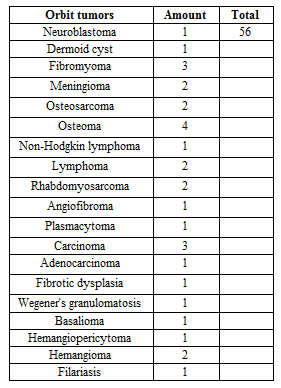
Table 1: According to histological analysis, we distributed the clinical cases.
Orbital tumors are various according location:
- associated with the apical part of the orbit;
- not associated with the apical part of the orbit;
- with intracranial growth,
- with growth in the paranasal sinuses.
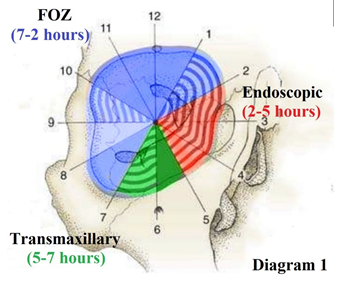
Diagram 1: Depending on the location of the tumor, different surgical approaches should be preferred, which is displayed in a pie chart
Optimal surgical approach should be minimally traumatic, as convenient as possible for visualization and manipulation, and contribute to achieving a high degree of radicalism, good functional outcomes and cosmetic results [5].
The principles of orbit microsurgery, until now, have not undergone significant changes and are actively used in modern cranioorbital approaches - supra-orbital, FOZ, lateral orbitotomy.
To remove an orbit tumor, cranioorbital localization, we pay special attention to organ-preserving operations using FOZ approach, which provides an optimal surgical access and minimizes damage to orbit structures.
Anatomical and topographic substantiation of FOZ approach (description):
1. Cosmetic skin incision along the edge of the scalp (Figure. 1).
2. To preserve the integrity of the anatomical structures, to prevent atrophy of the temporal muscle in the postoperative period, the muscle should be crossed 1.5 cm below its attachment to the bone with preservation of the muscle cuff. In the future, the muscle is stitched with a muscle cuff, which allows to restore its function, to avoid atrophy and consequently a cosmetic defect (Figure. 1).
3. Craniotomy is providing with 2 burr holes (BH), one of which is performed in a key point - at the junction of the alisphenoid and the zygomatic process of the frontal bone (Figure. 2).
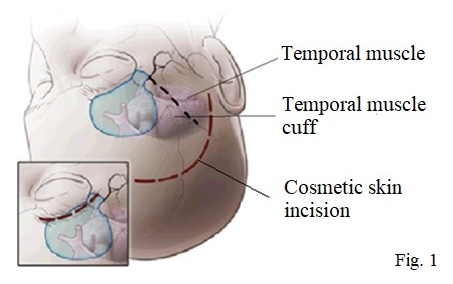
Figure 1: Cosmetic incisions of soft tissues by FOZ approach.

Figure 2: Burr hole in a key point.
The second - depending on the prevalence of the orbital process in the cranial cavity (to correct the size of the cranial part of the bone flap). The bone cut line was to the supraorbital foramen (for localization of tumors from 7 to 12 hours according to Diagram 1) or after the supraorbital foramen (for localization of tumors from 7 to 2 hours - marked by blue on the Diagram 1), including the apical part of the orbit, along the bone suture of zygomatic process. A fragment of a bone flap is freely removed, since the roof of the orbit is of very thin, is trepanning along the bone suture, within the anatomical borders (Figure. 3,4,5) [28].

Figure 3: Sizes of the trepanation window of the cranial part.

Figure 4: Bone flap by FOZ approach.
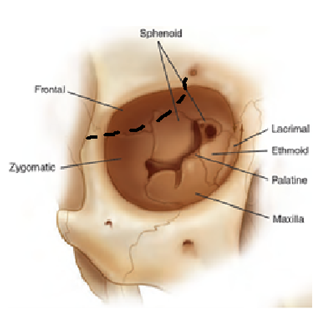
Figure 5: The seven constituent bones of the orbit: zygomatic, frontal, sphenoid, lacrimal, ethmoid, palatine, maxilla.
3. The bone window by such trepanation allows to examine all the structures of the orbit large enough to remove a tumor of the orbit of any location (from 1 to 7 hours, marked in blue in diagram 1) and sizes, with minimal damage to the structures of the orbit. (figure. 6,7). High radicalism with microsurgical removal of diffusely growing tumors is achieved using an ultrasonic aspirator, cold plasma, diathermocoagulation.
This approach allows to get the tumors in three different ways:
1) laterally through the space between the superior oblique muscle;
2) medially between the levator palpebrae superioris muscle and the superior rectus muscle;
3) laterally through the gap medially limited by the levator palpebrae superioris muscle, and the superior rectus muscle and the lateral rectus muscle.
The last of the three options was the most convenient and safe for approaching the optic nerve [27].
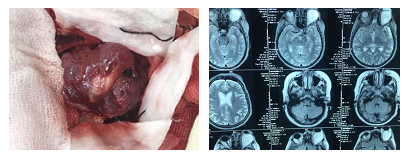
Figure 6: Bone window from which the tumor swells, next to the CT scan of this patient.
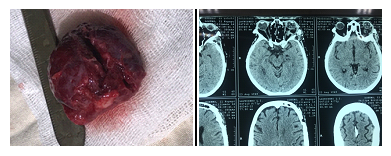
Figure 7: Remote tumor from the intermuscular funnel 4.0 x 4.5 x 4.0 cm, next to the patient’s CT scan after surgery.
4. After microsurgical removal of the orbit tumor, the bone flap is put on the place, fixed by two titanium bridges, without violating the anatomical integrity of the orbit. (Figure. 8.9) [28].
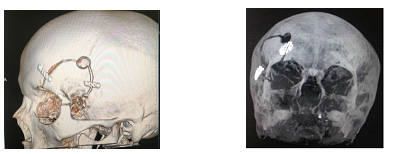
Figure 8 Fixation of the bone flap Figure. 9 Restored the integrity
with titanium bridges. of the orbit wall.
Subconjunctival approach by cantotomy. It is a less traumatic modern approach. It is used to remove tumors of the orbit in the lower medial, lower lateral surgical angles. This approach is not effective when the orbit tumors are located in the area of the intramuscular funnel, and can be used to remove hemangiomas, encapsulated neoplasms, less than 2.5 cm in size, and an open diffuse tumor biopsy. It does not quite meet all the requirements of modern oncology.
When it this refers to radical removal of the tumor with minimization of traction and damage to the structures of the orbit, leading to oculomotor disturbances, preservation of the organ of vision, one should resort to FOZ approach that meets all of above mentioned requirements.
FOZ approach in our opinion is the most ideal, universal for removing tumors of the orbit of various locations: the optic nerve canal, intermuscular funnel, lacrimal gland tumors, lateral, lower lateral orbit, osteoma of the orbit walls, meningiomas and diffuse orbit tumors of large sizes, including those spreading intracranially.
This approach is an alternative:
- 1. The technique of combined orbitotomy proposed by S. McCord in 1978.
The essence of a method consists in performing ordinary orbitotomy without dissecting of external periororbitis at the first stage. At the second stage, a conjunctival incision is made along the meridian of 9 or 3 hours, the medial rectus muscle is stitched with a ligature and cut off from the attachment site. For the remaining tendon of the medial rectus muscle the eye is fixed and displaced outwards. The absence of an outer wall allows to sharply take eye aside, which opens access to the top of the orbit.
- 2. Subconjunctival less traumatic approach is used to remove tumors of the orbit of the lower medial, lower lateral surgical angles. This approach is not effective when the orbit tumors are located in the area of the intramuscular funnel; it can be used to remove hemangiomas, encapsulated neoplasms, less than 2.0 cm in size, and open biopsy of the diffuse tumor.
Clinical case. The child is 2.5 years old.
In neurological status: ptosis, diplopia, pain syndrome, exophthalmos, visual impairment. Symptomatology increased in the above-noted order duaring 1 year. Patient was operated on with FOZ-approach. In the postoperative period - regression of the described symptoms. The histological response is hemangiopericytoma.

Figure 10: Tumor of the right orbit.
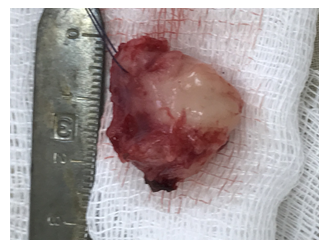
Figure 11: Remoted tumor node.

Figure 12: CT scan after surgery. The tumor was removed, compression of the optic nerve was eliminated, regression of exophthalmos.
1. Tumors of the orbit are common diseases. The main symptoms of the orbital tumors are - unilateral ptosis, exophthalmos, diplopia, pain syndrome, progressive visual impairment in one eye. With the exclusion of endocrine pathology, a diagnostic algorithm should be performed to identify or exclude the tumors:
- Ultrasound of the eye, as a screening study;
- CT with intravenous contrast, MRI, to clarify the prevalence of the process;
- ophthalmological examination, ENT specialist, neurologist.
2. The results of the treatment of patients with orbital tumors directly depend on the radicalism of the neoplasm removal, which is associated with the choice of surgical approach, the use of chemo-, radiation therapy in the postoperative period, depending on the histological response. In our opinion, the most universal method for removing orbital tumors of various localization and sizes is FOZ approach which provides the implementation of radical organ-preserving surgery, with the maximum preservation of visual function, minimizing oculomotor disturbances, and patient disability, despite its technical complexity for surgeons ophthalmologists. In this regard, surgery of orbital tumors and cranioorbital region is a subject to the competence not only ophthalmologists but also neurosurgeons.
Clearly Auctoresonline and particularly Psychology and Mental Health Care Journal is dedicated to improving health care services for individuals and populations. The editorial boards' ability to efficiently recognize and share the global importance of health literacy with a variety of stakeholders. Auctoresonline publishing platform can be used to facilitate of optimal client-based services and should be added to health care professionals' repertoire of evidence-based health care resources.

Journal of Clinical Cardiology and Cardiovascular Intervention The submission and review process was adequate. However I think that the publication total value should have been enlightened in early fases. Thank you for all.

Journal of Women Health Care and Issues By the present mail, I want to say thank to you and tour colleagues for facilitating my published article. Specially thank you for the peer review process, support from the editorial office. I appreciate positively the quality of your journal.
Journal of Clinical Research and Reports I would be very delighted to submit my testimonial regarding the reviewer board and the editorial office. The reviewer board were accurate and helpful regarding any modifications for my manuscript. And the editorial office were very helpful and supportive in contacting and monitoring with any update and offering help. It was my pleasure to contribute with your promising Journal and I am looking forward for more collaboration.

We would like to thank the Journal of Thoracic Disease and Cardiothoracic Surgery because of the services they provided us for our articles. The peer-review process was done in a very excellent time manner, and the opinions of the reviewers helped us to improve our manuscript further. The editorial office had an outstanding correspondence with us and guided us in many ways. During a hard time of the pandemic that is affecting every one of us tremendously, the editorial office helped us make everything easier for publishing scientific work. Hope for a more scientific relationship with your Journal.

The peer-review process which consisted high quality queries on the paper. I did answer six reviewers’ questions and comments before the paper was accepted. The support from the editorial office is excellent.

Journal of Neuroscience and Neurological Surgery. I had the experience of publishing a research article recently. The whole process was simple from submission to publication. The reviewers made specific and valuable recommendations and corrections that improved the quality of my publication. I strongly recommend this Journal.

Dr. Katarzyna Byczkowska My testimonial covering: "The peer review process is quick and effective. The support from the editorial office is very professional and friendly. Quality of the Clinical Cardiology and Cardiovascular Interventions is scientific and publishes ground-breaking research on cardiology that is useful for other professionals in the field.

Thank you most sincerely, with regard to the support you have given in relation to the reviewing process and the processing of my article entitled "Large Cell Neuroendocrine Carcinoma of The Prostate Gland: A Review and Update" for publication in your esteemed Journal, Journal of Cancer Research and Cellular Therapeutics". The editorial team has been very supportive.

Testimony of Journal of Clinical Otorhinolaryngology: work with your Reviews has been a educational and constructive experience. The editorial office were very helpful and supportive. It was a pleasure to contribute to your Journal.

Dr. Bernard Terkimbi Utoo, I am happy to publish my scientific work in Journal of Women Health Care and Issues (JWHCI). The manuscript submission was seamless and peer review process was top notch. I was amazed that 4 reviewers worked on the manuscript which made it a highly technical, standard and excellent quality paper. I appreciate the format and consideration for the APC as well as the speed of publication. It is my pleasure to continue with this scientific relationship with the esteem JWHCI.

This is an acknowledgment for peer reviewers, editorial board of Journal of Clinical Research and Reports. They show a lot of consideration for us as publishers for our research article “Evaluation of the different factors associated with side effects of COVID-19 vaccination on medical students, Mutah university, Al-Karak, Jordan”, in a very professional and easy way. This journal is one of outstanding medical journal.
Dear Hao Jiang, to Journal of Nutrition and Food Processing We greatly appreciate the efficient, professional and rapid processing of our paper by your team. If there is anything else we should do, please do not hesitate to let us know. On behalf of my co-authors, we would like to express our great appreciation to editor and reviewers.

As an author who has recently published in the journal "Brain and Neurological Disorders". I am delighted to provide a testimonial on the peer review process, editorial office support, and the overall quality of the journal. The peer review process at Brain and Neurological Disorders is rigorous and meticulous, ensuring that only high-quality, evidence-based research is published. The reviewers are experts in their fields, and their comments and suggestions were constructive and helped improve the quality of my manuscript. The review process was timely and efficient, with clear communication from the editorial office at each stage. The support from the editorial office was exceptional throughout the entire process. The editorial staff was responsive, professional, and always willing to help. They provided valuable guidance on formatting, structure, and ethical considerations, making the submission process seamless. Moreover, they kept me informed about the status of my manuscript and provided timely updates, which made the process less stressful. The journal Brain and Neurological Disorders is of the highest quality, with a strong focus on publishing cutting-edge research in the field of neurology. The articles published in this journal are well-researched, rigorously peer-reviewed, and written by experts in the field. The journal maintains high standards, ensuring that readers are provided with the most up-to-date and reliable information on brain and neurological disorders. In conclusion, I had a wonderful experience publishing in Brain and Neurological Disorders. The peer review process was thorough, the editorial office provided exceptional support, and the journal's quality is second to none. I would highly recommend this journal to any researcher working in the field of neurology and brain disorders.

Dear Agrippa Hilda, Journal of Neuroscience and Neurological Surgery, Editorial Coordinator, I trust this message finds you well. I want to extend my appreciation for considering my article for publication in your esteemed journal. I am pleased to provide a testimonial regarding the peer review process and the support received from your editorial office. The peer review process for my paper was carried out in a highly professional and thorough manner. The feedback and comments provided by the authors were constructive and very useful in improving the quality of the manuscript. This rigorous assessment process undoubtedly contributes to the high standards maintained by your journal.

International Journal of Clinical Case Reports and Reviews. I strongly recommend to consider submitting your work to this high-quality journal. The support and availability of the Editorial staff is outstanding and the review process was both efficient and rigorous.

Thank you very much for publishing my Research Article titled “Comparing Treatment Outcome Of Allergic Rhinitis Patients After Using Fluticasone Nasal Spray And Nasal Douching" in the Journal of Clinical Otorhinolaryngology. As Medical Professionals we are immensely benefited from study of various informative Articles and Papers published in this high quality Journal. I look forward to enriching my knowledge by regular study of the Journal and contribute my future work in the field of ENT through the Journal for use by the medical fraternity. The support from the Editorial office was excellent and very prompt. I also welcome the comments received from the readers of my Research Article.

Dear Erica Kelsey, Editorial Coordinator of Cancer Research and Cellular Therapeutics Our team is very satisfied with the processing of our paper by your journal. That was fast, efficient, rigorous, but without unnecessary complications. We appreciated the very short time between the submission of the paper and its publication on line on your site.

I am very glad to say that the peer review process is very successful and fast and support from the Editorial Office. Therefore, I would like to continue our scientific relationship for a long time. And I especially thank you for your kindly attention towards my article. Have a good day!

"We recently published an article entitled “Influence of beta-Cyclodextrins upon the Degradation of Carbofuran Derivatives under Alkaline Conditions" in the Journal of “Pesticides and Biofertilizers” to show that the cyclodextrins protect the carbamates increasing their half-life time in the presence of basic conditions This will be very helpful to understand carbofuran behaviour in the analytical, agro-environmental and food areas. We greatly appreciated the interaction with the editor and the editorial team; we were particularly well accompanied during the course of the revision process, since all various steps towards publication were short and without delay".

I would like to express my gratitude towards you process of article review and submission. I found this to be very fair and expedient. Your follow up has been excellent. I have many publications in national and international journal and your process has been one of the best so far. Keep up the great work.

We are grateful for this opportunity to provide a glowing recommendation to the Journal of Psychiatry and Psychotherapy. We found that the editorial team were very supportive, helpful, kept us abreast of timelines and over all very professional in nature. The peer review process was rigorous, efficient and constructive that really enhanced our article submission. The experience with this journal remains one of our best ever and we look forward to providing future submissions in the near future.

I am very pleased to serve as EBM of the journal, I hope many years of my experience in stem cells can help the journal from one way or another. As we know, stem cells hold great potential for regenerative medicine, which are mostly used to promote the repair response of diseased, dysfunctional or injured tissue using stem cells or their derivatives. I think Stem Cell Research and Therapeutics International is a great platform to publish and share the understanding towards the biology and translational or clinical application of stem cells.

I would like to give my testimony in the support I have got by the peer review process and to support the editorial office where they were of asset to support young author like me to be encouraged to publish their work in your respected journal and globalize and share knowledge across the globe. I really give my great gratitude to your journal and the peer review including the editorial office.

I am delighted to publish our manuscript entitled "A Perspective on Cocaine Induced Stroke - Its Mechanisms and Management" in the Journal of Neuroscience and Neurological Surgery. The peer review process, support from the editorial office, and quality of the journal are excellent. The manuscripts published are of high quality and of excellent scientific value. I recommend this journal very much to colleagues.

Dr.Tania Muñoz, My experience as researcher and author of a review article in The Journal Clinical Cardiology and Interventions has been very enriching and stimulating. The editorial team is excellent, performs its work with absolute responsibility and delivery. They are proactive, dynamic and receptive to all proposals. Supporting at all times the vast universe of authors who choose them as an option for publication. The team of review specialists, members of the editorial board, are brilliant professionals, with remarkable performance in medical research and scientific methodology. Together they form a frontline team that consolidates the JCCI as a magnificent option for the publication and review of high-level medical articles and broad collective interest. I am honored to be able to share my review article and open to receive all your comments.

“The peer review process of JPMHC is quick and effective. Authors are benefited by good and professional reviewers with huge experience in the field of psychology and mental health. The support from the editorial office is very professional. People to contact to are friendly and happy to help and assist any query authors might have. Quality of the Journal is scientific and publishes ground-breaking research on mental health that is useful for other professionals in the field”.

Dear editorial department: On behalf of our team, I hereby certify the reliability and superiority of the International Journal of Clinical Case Reports and Reviews in the peer review process, editorial support, and journal quality. Firstly, the peer review process of the International Journal of Clinical Case Reports and Reviews is rigorous, fair, transparent, fast, and of high quality. The editorial department invites experts from relevant fields as anonymous reviewers to review all submitted manuscripts. These experts have rich academic backgrounds and experience, and can accurately evaluate the academic quality, originality, and suitability of manuscripts. The editorial department is committed to ensuring the rigor of the peer review process, while also making every effort to ensure a fast review cycle to meet the needs of authors and the academic community. Secondly, the editorial team of the International Journal of Clinical Case Reports and Reviews is composed of a group of senior scholars and professionals with rich experience and professional knowledge in related fields. The editorial department is committed to assisting authors in improving their manuscripts, ensuring their academic accuracy, clarity, and completeness. Editors actively collaborate with authors, providing useful suggestions and feedback to promote the improvement and development of the manuscript. We believe that the support of the editorial department is one of the key factors in ensuring the quality of the journal. Finally, the International Journal of Clinical Case Reports and Reviews is renowned for its high- quality articles and strict academic standards. The editorial department is committed to publishing innovative and academically valuable research results to promote the development and progress of related fields. The International Journal of Clinical Case Reports and Reviews is reasonably priced and ensures excellent service and quality ratio, allowing authors to obtain high-level academic publishing opportunities in an affordable manner. I hereby solemnly declare that the International Journal of Clinical Case Reports and Reviews has a high level of credibility and superiority in terms of peer review process, editorial support, reasonable fees, and journal quality. Sincerely, Rui Tao.
